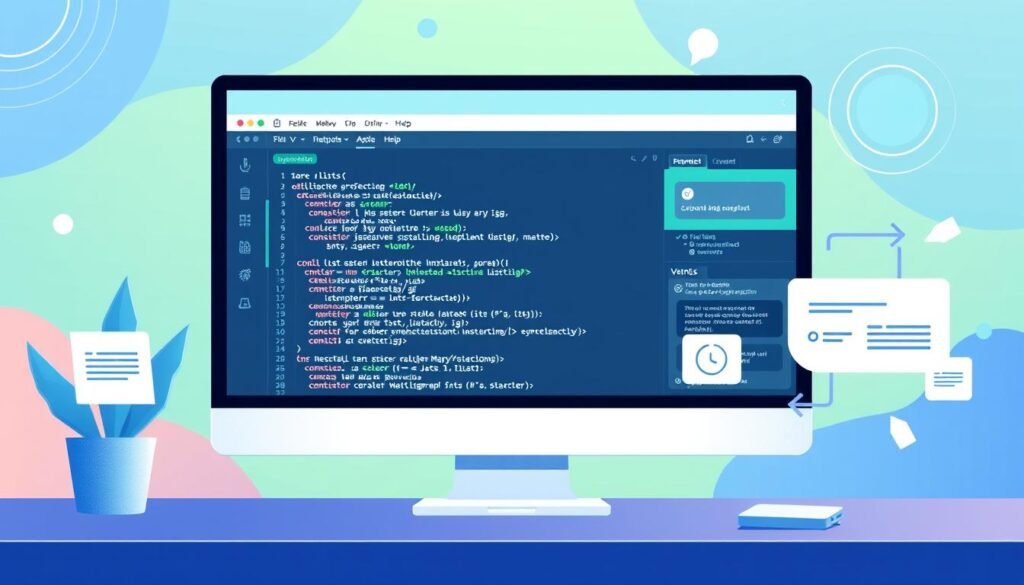JList is a powerful UI tool in Java Swing. It helps make cool lists for things like anime stuff or user screens.
JList lets coders make neat lists with lots of options. You can use it for Japanese snack lists or fun user stuff.
JList makes showing groups of things easy and fun. Smart use can make your Java apps look really good.
We’ll show you how to use JList from start to finish. You’ll learn to make lists look great and work smoothly.
Get ready to make your Java skills way better with JList. It’ll help you make great user screens that people love.
Introduction to JList in Java
JList is a handy Swing component for Java developers. It shows data collections in graphical interfaces easily.
This tool displays items in a scrollable area. It’s key for making interactive apps.
JList lets programmers create dynamic lists quickly. It works with various data types.
You can customize it for specific app needs. It’s great for desktop software and complex interfaces.
JList is a core part of Java’s Swing toolkit. It helps manage and change object lists smoothly.
It offers single and multiple selection modes. You can also use custom cell rendering.
JList works well with other Swing components. This makes it perfect for user-friendly Java apps.
It can show data from arrays, vectors, and custom models. Complex data structures become clear and organized.
This improves the user experience in Java interfaces. JList is a must-have for effective app design.
Setting Up Your Java Environment
Setting up Java is key for new programmers. It starts with installing the Java Development Kit (JDK).
The JDK has tools for making Java apps. You can get it from Oracle’s website.
Check your system before you install. Windows users can download it directly.
Mac and Linux users might use package managers. Make sure to set the system path right.
Choosing an IDE makes Java coding easier. Eclipse, IntelliJ IDEA, and NetBeans are good options.
These IDEs help with coding and fixing bugs. They also make managing projects simpler.
After installing, check your setup. Open a command prompt and type “java -version”.
This shows if Java is ready to use. Take time to learn your IDE’s tools.
A good setup is the start of your coding journey. Know your tools well to build great projects.
Creating a Basic JList
Java list components display data in graphical user interfaces. JList creation requires understanding core concepts of interactive list elements.
The DefaultListModel manages list data dynamically. It’s a key part of building JLists.
To create a JList, import Swing packages first. Then, initialize a DefaultListModel and add data to it.
String[] data = {“Apple”, “Banana”, “Cherry”, “Date”};
DefaultListModel listModel = new DefaultListModel();
for (String item : data) {
listModel.addElement(item);
}
JList myList = new JList(listModel);
Java list components are easy to customize. DefaultListModel has methods to change list contents.
These include addElement(), removeElement(), and clear(). They make JList great for showing collections.
To master JList creation, try different data types. Explore various configuration options too.
Add selection listeners and custom rendering. Integrate with other GUI components for better results.
Customizing JList Appearance
JList customization transforms Java lists into eye-catching interfaces. Developers use cell renderer capabilities to create stunning user interfaces.
UI design in JList offers more than basic color changes. Custom DefaultListCellRenderer controls every visual aspect of list items.
You can change backgrounds, fonts, and add icons to list elements. Override getListCellRendererComponent to define precise rendering behaviors.
Advanced customization supports multiple data types in complex cell renderers. You can use different colors, fonts, and custom components in list cells.
This flexibility allows developers to design interactive and visually rich interfaces. These techniques make Java applications stand out from the crowd.
Adding JList to a JFrame
Java developers use JFrame to make great user interfaces. JList fits into JFrame with good layout management.
Make a new JFrame and pick a layout manager. GridBagLayout or BorderLayout work well for most designs.
Import Swing packages to set up parts easily.
Create a DefaultListModel to fill your list with data. Use JList to bind the model.
Add the list to a JScrollPane for scrolling. This helps with big lists.
Place the JList in the JFrame carefully. Use add() with layout rules.
Put the JList in a JScrollPane for smooth scrolling. This makes it better for users.
Set your JFrame to show and give it a size. This finishes the setup.
Your interface is now ready for people to use.
Handling JList Events

JList event handling is key for interactive Java interfaces. ListSelectionListener captures user actions with list components.
To handle JList events, add a ListSelectionListener. This tracks selection changes and user interactions.
Write a method to capture selection events. You can get the selected item or its index.
The valueChanged() method is crucial in ListSelectionListener. It’s called when list selection changes.
JList event handling needs knowledge of selection modes. JList supports single, single interval, and multiple interval modes.
Advanced JList Functionality
Java Swing’s JList offers powerful features for interactive displays. It can turn simple lists into dynamic, user-friendly components.
Multi-selection lets users pick several items at once. It uses keyboard modifiers like Ctrl or Shift.
You can turn on this feature in your code. Set the selection mode to ListSelectionModel.MULTIPLE_INTERVAL_SELECTION.
JList works well with JScrollPane for smooth scrolling. This helps when dealing with long lists of data.
You can add filters to help users find items quickly. This makes list navigation easier and cleaner.
Custom rendering lets you style list items uniquely. You can change colors, fonts, and icons for each element.
These features help create engaging and responsive interfaces. They can adapt to meet specific app needs.
Search and filtering make lists powerful data tools. Add text field listeners and filtering logic for instant responses.
Integrating JList with Other Components
JList shines when paired with other UI components. This combo creates dynamic interfaces in Java Swing development.
JList and JButtons make a powerful team. Users can pick list items and act fast with buttons.
JTextField and JList work great for searching. As users type, the list updates in real-time.
JList and JComboBox offer multilevel selection. This duo helps users navigate complex data structures easily.
Code examples show how to implement these techniques. They help developers build user-friendly interfaces that respond well.
Persisting JList Data
Saving and retrieving JList data is vital for strong Java apps. File I/O methods offer powerful ways to manage JList content well.
Java serialization makes JList data storage simple. It turns list data into a byte stream for files or networks.
Use ObjectOutputStream and ObjectInputStream for JList file I/O. The writeObject() method saves the list. readObject() brings back the JList data.
Watch for errors during file tasks. Handle different data types in the list carefully.
Use try-catch blocks for file I/O and serialization. This helps manage errors in JList data storage tasks.
Best Practices When Using JList
JList needs careful handling for top performance. Developers should use key strategies for strong, quick list parts in Java apps.
Pick a data model that fits your app’s needs. Vector and DefaultListModel are common picks.
Custom list models work well for complex data. Light models keep the UI fast and use less memory.
Use smart rendering to boost speed. Try lazy loading or pagination for big datasets.
Use ListCellRenderer to change list items’ look quickly. This saves computer power and gives users a smooth experience.
Be careful with event listeners. Add them only when needed. Remove them fast to stop memory leaks.
Make selection handling methods that react quickly to users. Use SwingWorker for loading data in the background.
This keeps the app running smooth, even with lots of data. Test often to find slow spots in JList use.
Use Java tools to watch memory use. This helps make list parts work better.
Debugging Common JList Issues
Java developers often face challenges with JList components. Effective debugging requires a systematic approach to troubleshooting common problems.
Start by checking your selection model when debugging JList issues. Many developers make mistakes with JList selection retrieval.
Verify that your list model is properly set up. Make sure selection listeners are correctly implemented.
Java development tools offer powerful debugging features for JList problems. IDEs like IntelliJ IDEA and Eclipse provide robust debugging tools.
Use breakpoints to inspect list states during runtime. Track variable changes to identify issues quickly.
Examine event handling and model management when troubleshooting JList problems. Ensure list models sync with data sources correctly.
Configure selection modes appropriately. Watch out for incorrect list setup and improper event handling.
Implement comprehensive error checking in your JList code. Use try-catch blocks to manage potential exceptions.
Create robust JList implementations that handle unexpected scenarios well. This approach will lead to more stable Java applications.
Conclusion and Next Steps
JList in Java GUI opens up exciting user interface possibilities. It creates dynamic and responsive graphical interfaces.
Mastering JList requires practice and understanding of Java GUI principles. A strategic approach to component design is also essential.
To improve Java GUI skills, explore advanced Swing component techniques. Oracle’s Java docs offer great resources for JList and UI elements.
Practical projects with JList, data models, and event handling boost learning. They enhance your programming expertise too.
Practice and experiment to master JList. Try JTable and JComboBox to expand your GUI toolkit.
GitHub has open-source projects with advanced JList uses. These give insights into real-world app design.
Understanding Swing components is key in Java GUI development. Keep refining skills through coding challenges and hands-on projects.
Your commitment to learning will turn knowledge into programming skill. Keep exploring and growing in Java GUI development.
